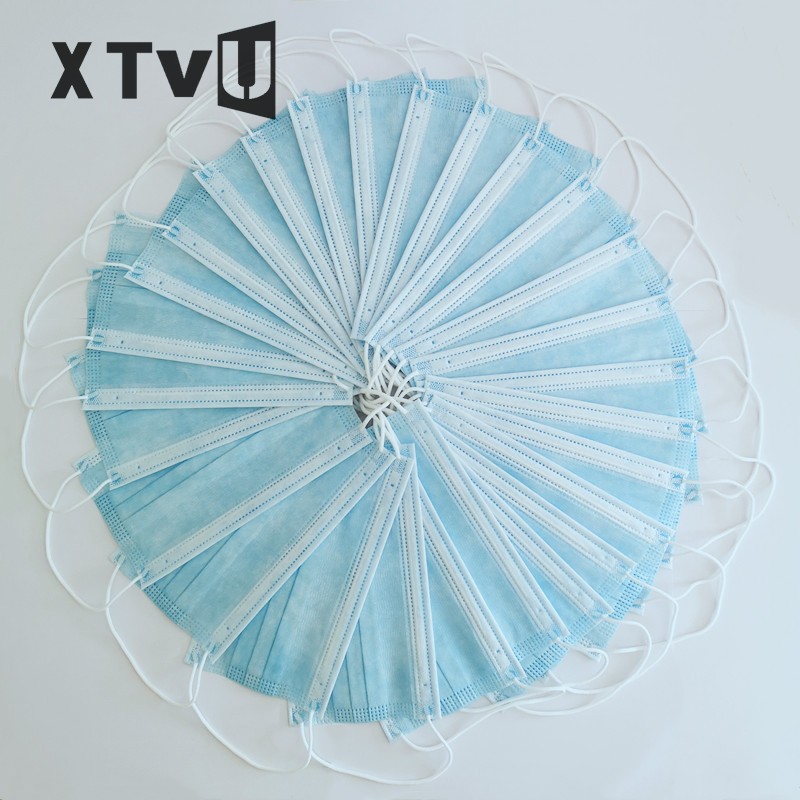Face shield vs. face mask: Which is better?
As temperatures and levels of frustration continue to rise during the pandemic, wearing face masks has become a hot topic of discussion. Masks may not be the most comfortable thing in the world, especially in the summer months, but they’re necessary right now to help prevent the spread of COVID-19. That said, while the Centers for Disease Control and Prevention (CDC) recommends face masks for most people, they do note a few exceptions, stating that “cloth face coverings should NOT be worn by children under the age of two or anyone who has trouble breathing, is unconscious, incapacitated, or otherwise unable to remove the mask without assistance.”
Fortunately, masks aren’t the only way to cover our faces. Could wearing a face shield be a good alternative to wearing a mask? Is it possible that it could even provide better protection? Here’s what the experts have to say.
Why we need to cover our faces during the pandemic
There’s so much misinformation about coronavirus out there, but one thing isn’t up for debate. “We know for sure that COVID-19 spreads through viral droplets (from direct exposure to a cough or sneeze of an infected person) and prolonged contact with an infected person,” says infectious-disease specialist Sandra Kesh, MD, the deputy medical director at Westmed Medical Group in Westchester, New York. While much of the information regarding COVID has changed since the beginning of the pandemic as scientists have learned more about it, Dr. Kesh wants to clarify that experts now suspect the virus can be spread via aerosols, if someone sneezes or coughs. “When this happens, particles can get in the air and be inhaled,” she explains.
And wearing a mask is important not only to protect yourself but also to protect others. Studies show that masks help prevent you from transmitting coronavirus germs to those around you—something that’s especially important since you can be contagious before you start showing symptoms and even when you’re fully asymptomatic and never come down with full-blown symptoms. Here are more eye-opening facts that will convince you to wear a face mask.
Do experts prefer face masks or face shields?

So, now to the question at hand. The CDC doesn’t recommend face shields over face masks (or vice versa), and there are no definitive studies proving one choice is better than the other for COVID-19 prevention. But some physicians laud the efficacy of shields as an option for protection. In a recent opinion piece in JAMA, Eli Perencevich, MD, a professor of internal medicine and epidemiology at the University of Iowa Carver College of Medicine, along with two of his colleagues, explained that face shields appear to significantly reduce the amount of inhalation exposure to the influenza virus, which, like COVID-19, is a droplet-spread respiratory virus. A simulation study found that face shields reduced immediate viral exposure by 96 percent when worn by a health care worker within 18 inches of a cough.
That said, the CDC, WHO, and most doctors endorse masks as a preferred line of defense. Why? “Masks offer a better way of preventing droplets from leaving the mouth or nose of someone who might be infected,” explains Dr. Kesh. The problem with a shield is that droplets can still escape from the side and bottom. “Additionally, our main portal of entry for the virus is the nose, so making sure the nose is fully covered will help to create a greater barrier for entry,” she says. Of course, face masks are only effective if you use them properly, so make sure to avoid these common mask mistakes.
Masks have more containment of the mouth and nose than shields do, but wearing a mask isn’t possible for everyone. “For those who cannot tolerate a mask, a shield could be better. But I would encourage my patients to try a few different masks before giving up,” says Dr. Kesh. “Something is better than nothing, but a mask offers better protection than a shield.” Here are some of the issues you should consider when making this decision.
Masks aren’t easy to breathe in
“Although wearing a face shield with a mask is the optimal form of use, face shields are more breathable than cloth masks are,” says Jen Podany, CEO of Bluestone Sunshields. “[For example], our customers in the restaurant industry can quickly move without feeling suffocated while wearing shields.” Plus, Bluestone Sunshields, in particular, can help you avoid strange tan lines from masks. While these shields are currently used as PPE, they were originally designed as sun protection for those with very sensitive skin. That said, not all face-shield brands block harmful UV rays, so do your research first.
Face shields can also be a good choice for those with respiratory issues, as well as people who are doing things that cause them to breathe heavier than normal. “People who are engaged in high-intensity activities, like running, may not be able to wear a cloth face covering if it causes difficulty breathing,” says Abe Malkin, MD, founder and medical director of Concierge MD in Los Angeles. “If you have respiratory issues, you should not risk your own health by wearing a mask.” So, while someone with asthma, for example, may be safe wearing a cloth mask to go grocery shopping, it might not be a smart idea if they’re exercising. In that case, a face shield is a safer alternative.
Masks are not recommended for people with some medical conditions
“There are cases like with autism or seizure disorders where a person may be more sensitive than other people to touch and texture and cannot bear the feeling of having the nose and mouth covered by fabric,” says Dr. Malkin. In those circumstances, a shield would be a better choice. However, Dr. Malkin says it’s sometimes best to skip a face covering altogether. “It is best not to force this,” he advises. “Instead, be mindful of social distancing and avoid places where you might expose others whenever possible.” Check out these 20 photos that will define the era of social distancing.
Where face shields have an advantage
One of the biggest problems with masks is that they only cover the nose and mouth, missing the other major entry point for the virus: the eyes. With face shields, the eyes are covered, preventing the absorption of the virus through aerosols as well as hand-to-eye contact. So, if you are a person who often rubs your eyes, a face shield might be a smart idea.
Masks can also cause skin issues, which, while treatable, are an annoyance. “I am seeing an increase in facial breakouts, including acne, rosacea, perioral dermatitis, and irritant contact dermatitis. I definitely think this is from wearing masks,” Sapna Palep, MD, of Spring Street Dermatology in New York City, tells Reader’s Digest. Shields don’t aggravate the skin.
Face shields are easier to clean
Masks should be cleaned at least daily. And if you sweat or exercise in your mask, it’s best to remove it when you’re done with your activity to avoid the potential skin conditions described by Dr. Palep. She recommends cleaning face masks with lingerie wash in a sink or putting them in the delicate cycle and then air-drying them. Either way, washing masks is a chore.
Another option is using a HoMedics Portable Sanitizer Bag. It has UV-C technology that kills up to 99.9 percent of bacteria and viruses at the DNA level. It’s also a chemical-free way to clean. While this device isn’t necessarily designed for cloth masks (its main uses are for phones, glasses, credit cards, etc.), it provides a fast way to clean them in between washes.
Face shields, on the other hand, are easier to clean than cloth masks because they have a hard surface. “You don’t have to do a load of laundry each time you wear it,” says Podany. But keep in mind that shields need to be cleaned after each use with soap and water. Still, the process is less time-consuming. Here’s what else you need to clean every time you return from the outside world.
Options for kids
As previously stated, the CDC doesn’t recommend masks for children under the age of two. But as many parents know, older children may be obstinate or pull off their masks. Dr. Malkin suggests “trying to make wearing a mask fun for kids by offering designs featuring their favorite superhero, calmly explaining the need for the mask, and keeping it a bit looser around the nose and mouth.” Dr. Palep also supports kids wearing shields if they won’t wear face masks because it’s better than wearing nothing at all. Plus, children may not be able to exercise caution when touching surfaces or avoiding touching their faces the way adults can, so a face shield designed specifically for kids can help with that issue.
Should anyone be wearing both a face mask and a face shield?
While wearing both a mask and shield provides the maximum amount of protection, most people don’t need to go that far. However, there are some exceptions. Los Angeles–based pediatric nurse practitioner Ersilia Pompilio, RN, recommends them for health care workers. “As one study shows, face shields substantially reduce the short-term exposure for health care workers to large infectious aerosolized particles,” she explains. “Thus, face shields provide a useful adjunct to respiratory protection for workers caring for patients with respiratory infections.”
Keep in mind that if you aren’t a health care worker but you live with someone who is immunocompromised or who has tested positive for COVID-19, then you may want to take additional precautions.
-
2023-05-13
Disposable Protectiv…
Disposable Protective Nylon Be…
-
2023-05-13
Wholesale Nonwoven B…
Wholesale Nonwoven Beard Cover…
-
2023-05-13
Disposable PE pedicu…
Disposable PE pedicure liner/s…
-
2023-05-13
Disposable Blue PE p…
Disposable Blue PE pedicure li…
-
2023-05-13
XTNU Non-skid blue s…
XTNU Non-skid blue shoe cover …
